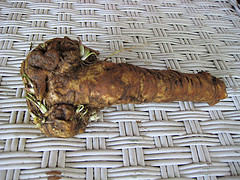Difference between revisions of "Horseradish"
| Line 33: | Line 33: | ||
Verticillium dahliae rot. | Verticillium dahliae rot. | ||
| − | |||
| − | |||
[[Category:Perishables]] | [[Category:Perishables]] | ||
[[Category:Products]] | [[Category:Products]] | ||
Revision as of 16:54, 14 March 2012
| Infobox on Horseradish | |
|---|---|
| Example of Horseradish |  |
| Freshness facts | |
| Optimum carrying temperature | 0°C |
| Highest freezing point | - |
| Acceptable product temp. at loading into containers | Max. 2°C above carrying temperature |
| Optimum humidity | 95% to 100% |
| Ventilation setting for containers | 10 m³/hr |
| Storage life | 8 to 12 months |
| Climacteric / non-climacteric | Non-climacteric |
| Ethylene production | Very low |
| Ethylene sensitivity | Low |
| Modified / controlled atmosphere | - |
| Potential benefits | - |
| Availability | |
| On demand | |
Horseradish
Harvesting and Handling
Horseradish is grown for its enlarged taproot, which is used as an appetizing condiment for meats and fish. The characteristic pungent aroma and taste comes from sulphur compounds.
Several criteria are used for quality evaluation of horseradish such as uniformity of shape and size, firmness, smoothness, freedom from hollow heart, internal colour of the roots, other defects and decay. Long and uniform roots with white colour of fleshy rhizomes and pungent flavour are the most important quality criteria.
Cooling and Storage
Horseradish are very sensitive to wilting. Immediately after harvest, roots should be pre-cooled.
Roots can be stored for 8 to 12 months at 0°C with 98% to 100% RH. Pungency is rapidly lost at higher temperatures, and roots dry out at lower RH. Perforated polyethylene bags and lined crates or bins can maintain a high RH during storage.
Horseradish roots are not chilling sensitive and can survive -7°C to -8°C.
Controlled atmosphere considerations There is no or only a slight benefit from CA.
Storage disorders
Verticillium dahliae rot.











